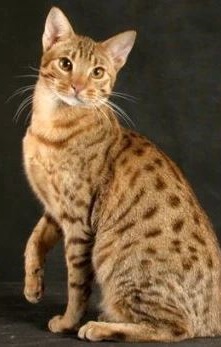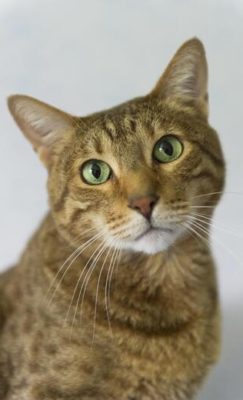Kanaani
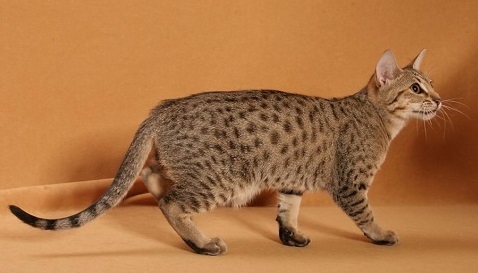
An intelligent cat has an independent temperament, just like its wild ancestors. The freedom-loving animal is better than walking on a leash. The Kanaani is not well adapted to moving. If it is necessary, it is necessary to create comfortable conditions.
Table of Contents
Breed Information
| Origin | Israel |
| Size | 25-32 cm |
| Weight | Males 6-8 kg Females 4-7 kg |
| Fur Type | Short-haired |
| Color | Tabby marbled, tabby spotted |
| Lifestyle | Outdoors, indoors |
| Lifespan | 12-15 years |
| FIFe Classification | – |
| WCF Classification | Group 3: “Short-haired” Breed designation – KAN |
| TICA Classification | – |
| Group | Short-haired cats, rare cats |
| Price | $700-1200 |
Breed Photos
Origin History
The breed appeared in Israel in the 1990s. Sculptor and artist Dorris Polacek bred the cat. Initially, she tried to cross a wild Libyan cat with a domestic cat. After many unsuccessful attempts, she succeeded. Based on Abyssinian, Bengal, and other oriental cats, a new breed was bred.
It got its name from the sacred area of Canaan. The Kanaani was fully formed only by the year 2000. At the same time, the cat received the breed standard and was registered with the International Canine Federation. Nine years later, the cat was also recognized by the World Cat Federation. Since 2008, it has been allowed to crossbreed Kanaani with representatives of the same breed.
Appearance
Kanaani is a medium build cat with a muscular and slender body. On the long neck of the pet sits a wide triangular head with a convex forehead. The cheekbones are visible, and the chin is well developed. The ears are widely planted and pointed at the tips. The large green eyes of Kanaani are usually almond-shaped.
The cat’s limbs are long and well developed. They end in oval black pads. The tail is long and thick at the base, tapering toward the end. The coat of the pet is short and dense; there is a small undercoat. The color can be different, necessarily presenting additional color.
Character
An intelligent cat has an independent temperament, just like its wild ancestors. The freedom-loving animal is better than walking on a leash. Kanaani is not well adapted to moving. If it is necessary, it is necessary to create comfortable conditions.
The pet becomes very attached to its owner and family members. It needs a lot of attention and does not tolerate loneliness. If you have little free time and are often away from home, this breed is not suitable for you. Kanaani loves to play, so it gets along well with children. There is a chance that the cat will let its claws out if the child hurts it. So explain to the baby how to behave with the pet. The cat is reserved towards other animals, and there can be conflicts with dogs.
Care
It is preferable to keep Kanaani in a country house where she will feel complete freedom. If you live in an apartment, make sure the cat gets enough exercise. Regularly walk it outdoors, preferably on a leash.
The pet’s short hair is easy to care for. A weekly combing is enough. You should bathe your cat about once every two months. Do not forget to clean the cat’s ears every week. The eyes should be wiped daily. If a cat spends most of its time at home, keep a close eye on its nails. Trim them every ten days.
Education
Early socialization is important when raising a Kanaani. The cat’s temperament is far from rosy. It can show an independent character and freedom-loving. As for the pet’s habituation to the litter box and scratching post, there is usually no problem.
When teaching your cat useful commands and tricks, be tolerant and lenient. Under no circumstances do not raise your voice or use force towards the cat. After this, it will not listen to you; on the contrary, it will withdraw its attention. Walk more with your pet in the fresh air. Give her a chance to explore the world around her.
Common Diseases
The young breed possesses excellent health. There is no evidence of a predisposition to genetic diseases. But, unfortunately, the Kanaani has a predisposition to heart disease – cardiomyopathy. It is worth paying attention to the cat’s diet to avoid gastrointestinal problems.
Also, don’t forget to take care of your pet’s teeth. To avoid tartar, they need to be brushed every week. Take your pet to the veterinarian regularly. Get her vaccinations and deworming as needed.
Nutrition
Take a responsible approach to feeding your Kanaani. Do not overfeed to avoid obesity and stomach problems. You can feed the cat both natural food and dry food, but always premium food. A combination diet is possible.
Protein and carbohydrates should form the basis of the diet. The first ones are found in large quantities in meat, e.g., chicken or beef. Give your cat cereals such as rice, oatmeal, and buckwheat. They are rich in carbohydrates, which are necessary for the healthy growth of the pet’s body. Dairy and fermented dairy products are also helpful.
Don’t forget fruits and vegetables. They contain many vitamins and minerals, which is good for the animal. It is categorically not recommended to feed Kanaani with salty and sweet foods and fatty foods. It can provoke kidney, liver, or stomach diseases.
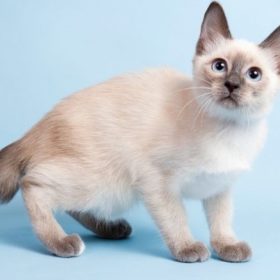 Toybob (Skif-Thai-Don)
Toybob (Skif-Thai-Don)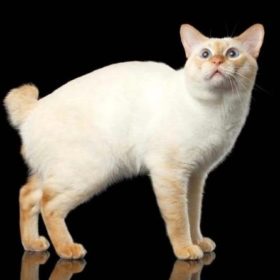 Mekong Bobtail
Mekong Bobtail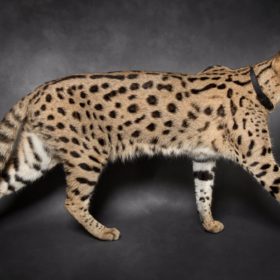 Savannah
Savannah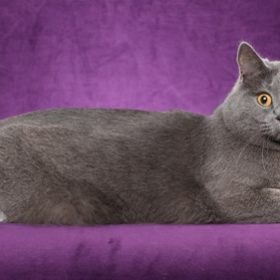 Chartreux
Chartreux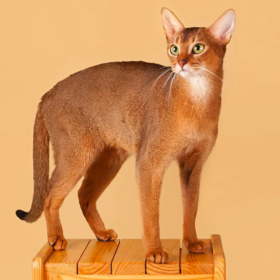 Abyssinian
Abyssinian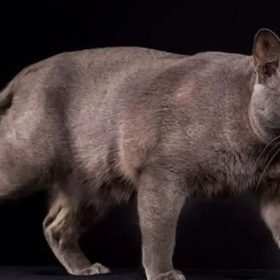 Korat
Korat